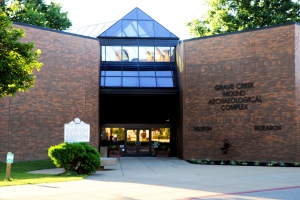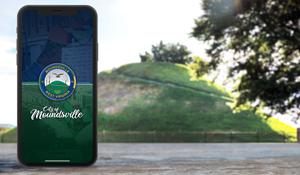Grave Creek Mound & Archaeological Complex

The Grave Creek Mound Archaeological Complex is the site of one of the most famous and the largest of the Adena Burial mounds. Artifacts and exhibits interpreting the lifestyle of the Adena people are displayed in the Delf Norona Museum, adjacent to the 2,000 year old mound.
The most impressive and largest Adena mound, Grave Creek Mound is the largest conical type of any of the mound builder structures. Construction of the mound took place in successive stages from about 250-150 B.C. In 1838, road engineers measured its height at 69 feet and its diameter at the base at 295 feet.
The site is also home to the State of West Virginia's Archaeological Collection.
The Grave Creek Mound is one of the largest Adena mounds and an impressive sight for any visitor to Moundsville. A massive undertaking, the total effort required the movement of more than 57,000 tons of sand and earth. Construction of the mound took place from about 250-150 B.C. and included multiple burials at different levels within the structure. Originally a ditch about 40 feet wide and five feet deep encircled the mound and at least one causeway led up to the monumental structure. Although Grave Creek Mound is today an isolated feature on the landscape, the flat area now occupied by the city of Moundsville was once covered with small and large mounds and associated earthworks. Unfortunately, these structures and many others all over the region have been destroyed by treasure-hunters and farmers who plowed over these in the past.
The first recorded excavation of the mound took place in 1838 and was conducted by local amateurs. To gain entrance to the mound, two horizontal tunnels and one vertical shaft were dug. This led to the discovery of two burial vaults containing human remains and their grave goods, which may have been placed with them as reminders of the lives they once led, as offerings to the dead, or as equipment for the afterlife. In the 1970s the first professional archaeological investigation of Grave Creek Mound was conducted. This project involved systematically excavating multiple trenches around the base of the mound and extracting soil samples from the mound itself. The data garnered from this investigation provided radiocarbon dates for the mound and evidence for continuous construction by basket-loads of soil.
The Grave Creek Mound is an exceptional site. Although most mounds are much smaller than the Grave Creek Mound, the monumental size must have been an important and purposeful feature of its construction and likely led to its preservation by early landowners. Today, the mound is a vital physical reminder that the landscape was once populated by prehistoric Native American peoples and their mounds, villages, and earthworks.
The Grave Creek Mound, as well as other mounds and earthworks, are sacred sites to Native Americans. We ask that visitors reflect on the indigenous people who built the mound and conduct themselves with respect.



